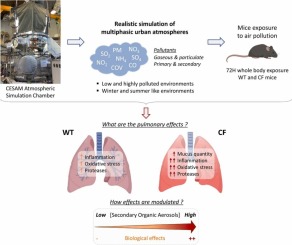Publication on Journal of Hazardous Materials
Acute exposure to realistic simulated urban atmospheres exacerbates pulmonary phenotype in cystic fibrosis-like mice.
Authors: Blayac M, Yegen CH, Marj EA, Rodriguez JCM, Cazaunau M, Bergé A, Epaud R, Coll P, Lanone S
Abstract
Cystic Fibrosis (CF) is a lethal genetic disorder caused by pathogenic mutations of the CFTR gene. CF patients show a high phenotypic variability of unknown origin. In this context, the present study was therefore dedicated to investigating the effects of acute exposure to air pollution on the pulmonary morbidity of a CF-like mice model. To achieve our aim, we developed a multidisciplinary approach and designed an innovative protocol using a simulation chamber reproducing multiphasic chemical processes at the laboratory. A particular attention was paid to modulate the composition of these simulated atmospheres, in terms of concentrations of gaseous and particulate pollutants. Exposure to simulated urban atmospheres induced mucus secretion and increased inflammatory biomarkers levels, oxidative stress as well as expression of lung remodeling actors in both WT and CF-like mice. The latter were more susceptible to develop such a response. Though we could not establish direct mechanistic link between biological responses and specific components, the type of immune response induced depended on the chemical composition of the atmospheres. Overall, we demonstrated that air pollution is an important determinant of CF-like lung phenotypic variability and emphasized the added value of considering air pollution with a multi-pollutant approach.

